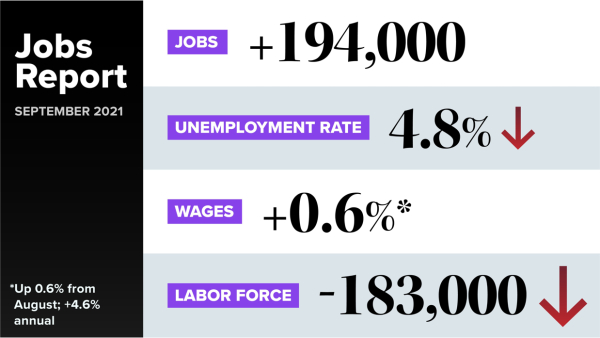Worker Shortage Crisis Continues to Threaten Economic Recovery
excerpt by US Chamber of Commerce
The unemployment rate fell in September but 10.4 million jobs went unfilled in August, after a record high in July.
Why it matters: The worker shortage crisis continues, affecting businesses of all sizes, across industries and is a reminder that our economic recovery remains fragile.
Our take: “With open jobs exceeding the number of people looking for work by over 2.7 million, the workforce shortage is the single most significant threat to America’s economic recovery. Coupled with Friday’s disappointing employment figures, this is yet another reminder that the recovery remains very fragile,” Chamber President and CEO Suzanne Clark explained. “Congress should drop the multi-trillion-dollar tax and spend proposals that would further undermine the economy and focus on getting Americans back to work and helping employers fill open jobs.”
What we’re doing: The Chamber strives every day to support employers and strengthen America’s workforce. For instance:
- This week, the Chamber Foundation’s Talent Pipeline Management Fall Summit will gather employers to collaborate on workforce building opportunities and best practices.
- On October 14, the next edition of Common Grounds with Rep. Nancy Mace (R-SC) and Rep. Mikie Sherrill (D-NJ) will discuss how childcare remains a significant barrier to reentering the workforce.
- The Chamber Foundation’s Hiring Our Heroes program holds virtual career fairs weekly to connect employers to transitioning service members, military spouses, veterans, and caregivers. Learn how to join one.
- Read our latest research on The Business Case for Second Chance Hiring.
- Learn more about the Chamber’s America Works policy agenda, workforce solutions for businesses, and the latest research on the impact of the worker shortage.
September Jobs Report Shows Big Labor Force Decline

The September jobs report was a huge disappointment. The Bureau of Labor Statistics (BLS) reported the economy added only 194,000 jobs during the month. The consensus estimate was for nearly 500,000.
Why it matters: Job growth has slowed way down. We added 1.1 million jobs in July and 366,000 in August. Those figures were both revised up in this report, so September’s could rise too in subsequent revisions. Jobs in state and local education fell by 160,000. That could be an anomaly with the data that will smooth out in the October numbers given schools reopened more in September than in 2020. However, the overall September figure will likely still be a big miss. With the added jobs, the gap between current employment and the level in February 2020 fell to just under 5 million – still very large.
Details: The unemployment rate fell from 5.2% in August to 4.8% in September, but only because of the drop in the labor force.
Be smart: Perhaps the most concerning aspect of a troubling report is that the labor force declined by 183,000 workers. Workers should be flooding into the labor market as jobs are plentiful and businesses are desperate for workers. That they are going the other way is alarming.
—Curtis Dubay, Senior Economist, U.S. Chamber of Commerce